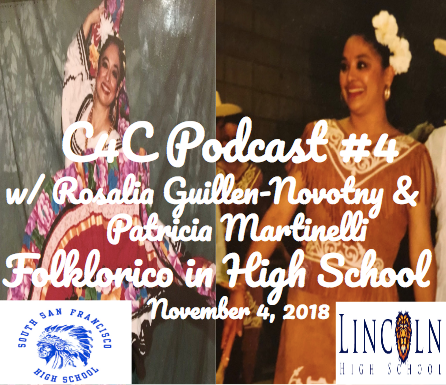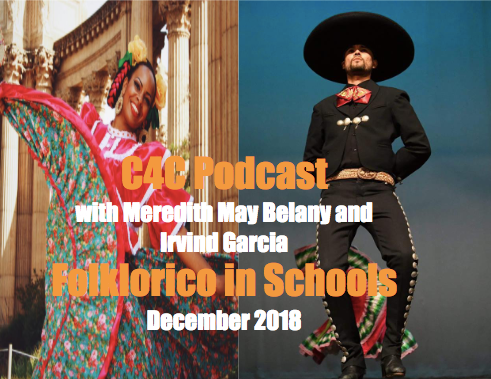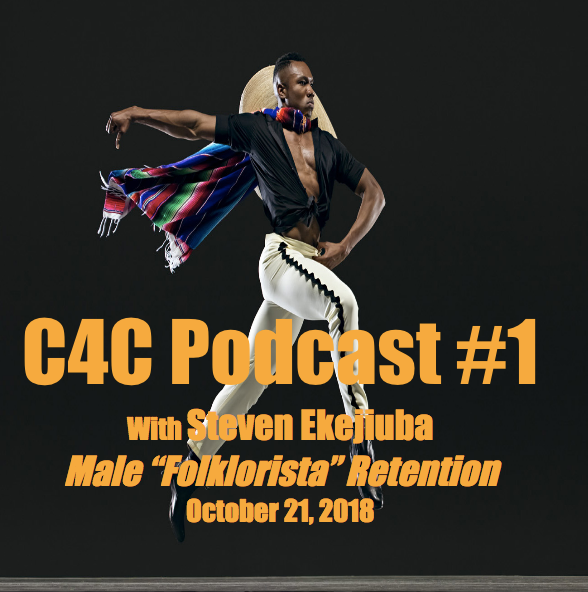C4C Podcast #5: Book Discussion - "Dancing Throughout Mexican History"
- Christopher Sandoval

- Nov 12, 2018
- 7 min read
Updated: Dec 27, 2018
C4C Director Christopher Sandoval and esteemed colleague Genesis Tamara Ibanez will be engaging in a discussion of a recent publication of Mexican folk literature, "Dancing Throughout Mexican History" (1325-1910) with its editor Gabriela Mendoza-Garcia, Ph.D. Dr. Mendoza-Garcia is a scholar, choreographer, and an educator who firmly believes in serving the art within its historical and artistic context. Dr. Mendoza-Garcia, Ibanez, and Sandoval will be reflecting on their impressions and points of interest of the publication, how it serves as a resource for Mexican folk dance practitioners, and how perspectives have evolved from then to now in researching Mexican folk dance.

Preface
Teachers are life-long learners, and in theory everyone should be as well. Dr. Gabriela Mendoza-Garcia states, "As a folklorista, we have to be grounded in our history of Mexican dance." I can not agree with her more. This teacher belief of learning and Dr. Mendoza-Garcia's statement reinforces the pride of owning and the pursuit of finding literature that can continue to inform our work as Mexican folk dance teachers. Let's be clear about this complex role of teaching Mexican folk dance. For our dance students we need to be their library of initial information, their relentless trainer of poise and technique, their public servant and voice, their resilient mentor, and even their counselor or parent.
In this podcast we focus on discussing a recent publication (available on Amazon.com) that can be a useful resource and addition to your folklorista library. This book is a dissertation by the late Dr. San Juanita Martinez-Hunter from the 1980's, and is edited by her niece Dr. Gabriela Mendoza-Garcia. We hope you get a glimpse of the spectrum and wealth of information that is discussed about this book with co-hosts Genesis Ibanez (Director of Grupo Folklorico Heruvi Kalo) and Christopher Sandoval (C4C Project Director), and the book's author Dr. Gabriela Mendoza-Garcia (A Folklorico Legacy!) Some major talking points you will find in the highlights are: 1) Reader First Impressions, 2) How can this book serve the folklorista? 3) How has this piece of literature evolved over time in historical truth and for artistic presentation? 4) The stories and bond that is shared within family and folklorico.
Podcast Highlights
Reader First Impressions:
A great starting point to teach folkloristory to students, and have it as a handbook ready to arm your Mexican folk dance lessons with.
A very digestive read. Each of the four chapters held an historical narrative of the time period, then a detailed chronology of events, and then a very detailed insight in how dance developed in this time period.
It offers a different approach to disseminating historical background behind certain periods or regional styles of Mexican Folk Dance.
How can this book serve the folklorista? :
For the teacher: Using this book can be a reference tool on hand to pull out broad characteristics of a time period or regional style, but also search deeper for interesting findings and intersectional details. For example, Dr. Mendoza-García clarifies that this book narrates the reasons why the sones and jarabes were banned during the Spanish Inquisition. These dances would later serve as a precursor to the jarabe tapatío, son de la negra, and others that we dance today.
For the parent: Having this book accessible for the family can allow for better retention of knowledge for the student when discussing with their parent's own connections about what they learn.
For the student project: Choosing a chapter, time period, topic of dance to study thoroughly after skimming through the entire book. Then refer to those annotations and the bibliography to find other texts that can help strengthen your report. An interesting topic to think about when studying Mexican folk dance from 1810-1910 (what we usually see as folklorico on stage today): Sones and jarabes in all its regional styles and significances.
How has this piece of literature evolved over time in historical truth and for artistic presentation? :
Dr. Mendoza-Garcia: Scholars believed that sones from Jalisco did not have an African influence, however Mexican scholar Gabriel Saldivar from the 1930's surmised in his thesis that there were African communities in Jalisco contributing to the culture musical influences. This addresses a larger issue of the country's socio-ethnic perspective where trying to unify the country as mainly mestizo consequently isolated Africans to only certain contributions to culture such as Veracruz or Guerrero. Since the late 1990's scholars are now including African influences in sones.
Dr. Mendoza-Garcia: Historically, scholars believed it to be certain that the Aztec civilization perceived the invading Spaniards as gods. Scholars today argue that this is only a myth. There is no empirical evidence or writings by the Spaniard in charge of the conquest, Hernan Cortes, that he and his fellow Spaniards were viewed as gods. However, a poem was discovered describing the meeting between Hernan Cortes and King Moctezuma expressing how the Aztecs viewed the Spaniards as gods. From this interpretation forward, it has carried on until recent years as a myth.
Genesis: Is enough conversation and accountability about new or modified historical findings such as these being had to assure that the most objective perspective of history is being taught to our students in schools K-21? We need to ask questions. History should be not repeating itself in an unaccountable way, because it can be harming our students.
Chris: Reflecting over the dawn of Amalia Hernandez's Ballet Folklorico de Mexico in the 1950's (not 1970's, my correction) to today, no longer is the debate of what "stylized" and "traditional" folklorico a central topic of interest for myself. I am more interested in if and how we are aware of what from a evolution of regional dance style and cultural wardrobe emerged from an artistic/aesthetic vision or a true authentic/socio-ethnic origin.
Dr. Mendoza-Garcia: A way to approach students before learning and presenting a dance region or style, it is important to discuss questions with them. "We are dancing the song of Sinaloa, does it come from a community of people or the stage?" Explain the difference between traditional and stylized ways of dancing such as using the paleacate in Guerrero as adopted by Amalia Hernandez or in the authentic way of communicating with your partner on a tarima.
The stories and bond that is shared within family and folklorico:
Dr. Mendoza-Garcia (historical context): Dr. Sanjuanita Maritnez-Hunter, to her family she was called "Chata", was a member of her H.S. dance team in the 1960's in Laredo, TX. Her teacher was a alumni of Texas Women's University dance program, and she aspired to be like her. So, Dr. Martinez-Hunter studied dance at the same university, and continued to keep her Mexican and Spanish folk dance background relevant in her collegiate dance training. After college, she became a dance faculty member at the University of Texas, Austin where she taught Mexican folk, Spanish folk, Modern dance and Ballet. Here she helped start the UT Austin Ballet Folklorico in 1975. Racism and prejudice played against her vision to transition the collegiate folklorico club from Physical Education to Sports and Recreation. Once she succeeded, she was able to create other dance teams such as the UT High Steppers and the Ballroom Dance Club.
Dr. Mendoza-Garcia: It is very clear that Dr. Mendoza-Garcia aunt's preservation of her cultural identity through dance passed down to her. Being a vivid role model of success for Dr. Mendoza-Garcia, she encouraged her to attend the college she was served as a faculty member. Dr. Mendoza-Garcia later studied there, and became a member of the UT Folklorico group at the university under founding member Michael Carmona. She was later encouraged by her aunt after this period of training to learn under the direction of Roy Lozano and his ballet folkorico company. During her PhD studies at the University of Laredo, her aunt became a backbone for her to see to her success. Dr. Martinez-Hunter was an extroverted spirit that held a resounding presence of voice and character with those around her.
Genesis Ibanez: It is interesting to see how legacies left behind by folkloristas continue to build pipelines for more access to Mexican folk dance for students. Family support has been extremely appreciative in times of struggle and growth as she directs her professional Mexican folk dance group.
Christopher Sandoval: Mexican folk dance can have a deeper connection within a family that engages in folklorico because there is a few hundred years of history the family can share from different generational perspectives.
Findings
Behind every legacy of folklorico on this side of the border I have had the pleasure of hearing, I have never heard the same type of story twice. Struggles may be similar, and every gain is a crucial stepping stone to get to where the story ends or continues today. I find it to keep myself accountable to continue reading and building my folklorico library for pleasure and growth. I don't believe that Mexican folk dance practitioners are promoting a culture of reading with and teaching history enough to students in a Mexican folk dance space, not to say they are not promoting that culture or mindset within themselves. I justify this by having attended a variety of folklorico productions and dance spaces, and not seeing an equitable amount of time or access for students, families, and the public. I also am not insinuating that I always operate with fidelity when finding a balance of history, discipline, and conciencia within my own students.
What is important is that in order to solve a problem, you have recognize there is one. The problem I can see is students are becoming apathetic/passive to wanting to learn what makes the dances they learn so amazing that they are, as opposed only to wanting to learn how to do them. Critical thinking and constructive conversations should be a shared experience between teacher and students. As an educator, I feel self-motivation amongst students in learning anything today seems like a fading trait. Nonetheless, I digress, I feel this text is a rich tool of knowledge in addition to many others that we can bring into our teaching spaces. Kids can best imitate what they see done as habit better than what is done as a special occasion.





Comments